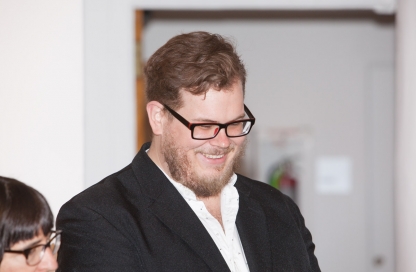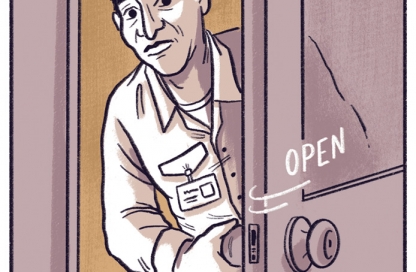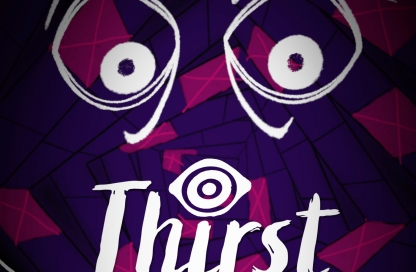The Visual Narrative Thesis Projects: Jenny Goldstick
Jenny Goldstick has impressed students and faculty alike with her perspective on the world, and her ability to visualize that perspective with her work. From her fantastic Sketchbook Notes, to her t-shirt design (with the fantastic Nadia DeLane) she always invites people see things from a unique angle. Jenny’s thesis project looks to be as cool as her previous work. We got to chat with her about the project, her perspective on memory and the future!
Where do you hang your hat these days?
I live in Brooklyn by way of Chicago.
What’s your story about?
My project is a semi-autobiographical story centering on the memory of a high school breakup that served as a turning point in my life, helping me to grow up and leave home. This interactive, sequential experience will attempt to convey the fluid and subjective nature of this memory, which is highly emotional, complex, and (increasingly) distant.
Why are you telling it?
I am telling this story because I am interested in attempting to quantify that which is unquantifiable. There is no more subjective data set than that of a highly emotional, first person account of the past. I wanted to tell an unobjective emotional story that I could apply a diagrammatic, informational approach to, and watch the consequences of the experiment unfold. I’m interested in the idea that the exact truth of any given event in day to day life doesn’t really matter — and that truth itself is subjective anyway. All we can rely on is emotional truth, and so this story attempts to portray that as appropriately and logically as possible.
Any additional locations you might be working in or visiting for your thesis, other than your current residence/studio?
At the beginning of this project, I had a plan to go home for an extended stay (up to a month), to complete research, interviews, take photo reference, and make drawings around town. However, budgetary restraints and other obligations prevented me from doing this, and so for the first few months of the project, I had nothing but my memory and what I could string together from old emails and random memorabilia hiding in the backs of drawers to piece this story together. I think starting the project this way was actually way more interesting than being able to get up close to the space of the memory because I both literally and figuratively experienced this struggle to get back to the feeling of “home” and what it felt like to be in that moment of heartbreak. I was able to make it home over holidays and a few other visits and collect some research to help inform the story, but I feel grateful for that initial glitch just because I think the distance actually helped me figure out how I should tell this story–it is something buried deep in my mind, that I am desperately trying to make come alive. It’s like a memory seance, really.
Tell us about working with your mentor.
I am working with Richard McGuire, who is an artist working on many different types of projects in different media. His full-length graphic novel, Here, was recently released by Pantheon as both a book and an interactive app/e-book. It is a sequential work that centers around the single room of a house and jumps backward and forward in time. It is really something. I have greatly appreciated Richard’s wisdom on a number of points in my project, but what I like best is shooting around crazy ideas about structure and format.
What does visual storytelling means to you?
To me, visual storytelling is trying to most appropriately* represent a sequential idea through imagery. *Most appropriate solution subject to intention of visual storyteller.
Why did you choose the MFAVN program?
For me, a driving narrative force has always been most important to me as a designer and illustrator. All the tools to achieve that are just a means to an end. I had considered programs in journalism, film, and design, but nothing ever seemed quite right until I stumbled upon this one.
Where do you hope your work and thesis will take you ?
In terms of conceptual thinking, I continuously am trying to resolve the idea of quantifying the unquantifiable, a task I know I can never achieve. I am also interested in continuing to explore how increasing amounts of data available with technology affects our culture and psychology, and what that means for storytelling. I think interactivity will be important to my future work because my inclination to apply information design principles to narrative, sequential work often results in a non-linear story. Interactivity and the web environment in general seem important to exploring non-linear storytelling because they dramatically widen the possibilities for a story’s shape. In terms of where I hope the work and thesis will take me technically and professionally, I hope to continue honing my UX skills and abilities to work fluidly with a developer (which I already have some experience doing in an infographic capacity). I also hope to show how I can parse through the complex data set of my own life and distill it into a meaningful story. Professionally, I do hope to continue taking on projects where data visualization/representation is needed, but I hope to move more into and editorial and artistic realm with it in addition to simply coming up with metaphors to explain complex IT products.
Where can we find you online?
Thanks for talking to us, Jenny!


